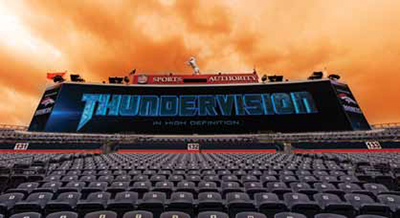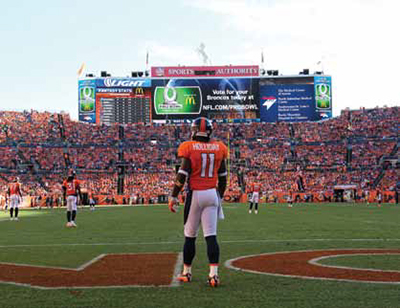Sports Authority Field Undergoes a Massive AV Renovation
The $30 million upgrade to Denver’s Sports Authority Field at Mile High includes a massive new scoreboard and fascia signage together with new video and audio systems in the main bowl and suites, club rooms, and public concourses, all tied back to a new control room. DENVER, CO—“Elevating the fan experience” is the slogan at Sports Authority Field at Mile High, which last year spent over $30 million on a major audiovisual system renovation. Major upgrades at the stadium, which was built in 2001 and is home to the Denver Broncos football team and Denver Outlaws lacrosse team, include a massive new scoreboard and fascia signage together with new video and audio systems in the main bowl and throughout the suites, club rooms, and public concourses, all tied back to a new control room.
Dallas-based Wrightson, Johnson, Haddon and Williams (WJH W) designed the new AV systems. Sony handled overall integration, subcontracting the control room to Beck Associates, which maintains a local office. AT&T and Cisco teamed-up for the new IP TV system, in collaboration with moeBAM! Venue Media Services of Florida. Parsons Electric of Minneapolis, MN was responsible for installation of the new audio system.
At the south end of the stadium, the highlight of the renovations is a new Daktronics 222-foot by 40-foot HD video board, constructed from one-foot-square modules and emitting 7,000 nits of luminance from nearly eight million LEDs. The concave screen, which replaced a series of static signs, is flanked by two 16-foot screens that are angled backwards. There is an additional pair of Daktronics 64-foot by 30-foot screens at the north end and a 1,424-foot by 42-foot ribbon display running along the club level fascia.
A Cisco StadiumVision IP TV system, supplied by AT&T, feeds approximately 1,100 Sony HD monitors up to 52 inches in size installed throughout the concourses and premium hospitality areas, some configured in two-by-three video walls and some oriented vertically. Content from the main control room can be fed to an individual screen, to groups, or every screen. “They are used not only to broadcast the game but also to sell advertising on, and for digital signage at the concessions,” said Mark Graham, an associate with WJH W.

A new Daktronics 222-foot by 40-foot HD video board is flanked by two 16-foot screens. There is an additional pair of Daktronics 64-foot by 30-foot screens at the north end and a 1,424-foot by 42-foot ribbon display running along the club level fascia. The equipment complement in the new control room includes a Ross Video Vision switcher with Evertz Xenon video and EMR audio routers, as well as multiple Grass Valley K2 Dyno replay servers and a Ross Blackstorm playout server. Additional inputs include six wired Sony HD cameras and two IMT Nucomm wireless cameras. Operators typically also have access to up to 10 camera feeds from the game day broadcaster. Various Ross platforms support motion graphics, character generation, and social media integration.
Also in the control room, Parsons installed a Yamaha M7-CL32 digital mixing console. New Riedel Artist digital matrix and Clear-Com Tempest wireless intercom systems provide coverage throughout the venue.
Jeremy Wecker, the stadium’s audiovisual services manager, solved the challenges of severe weather and a chaotic RF environment, which previously demanded the use of wired microphones, with the addition of a Shure Axient Wireless Management Network. Wecker reportedly also employs Shure’s Wireless Workbench 6 software for frequency coordination and remotely manages transmitter and receiver settings via Axient’s ShowLink Remote Control.

A fully redundant QSC Audio Q-Sys Core 3000 DSP platform handles general processing and facility-wide digital signal distribution of a JBL bowl system powered by Lab.gruppen amps. Parsons Electric, led by field engineer David Potts, handled the installation of a reported 700 to 800 speakers distributed throughout the main bowl, replacing 500 to 600 of the previously installed units, which were reused in the concourse areas. While the 10AWG wiring installed for the previous PA was not ideally located, “To replace the conduit and cabling in order to get what I would typically design these days for speaker spacing and zoning would have probably run upwards of a quarter-million dollars,” said Graham, who specified a number of custom-designed speakers to overcome placement restrictions.
The new seating bowl system includes more than 60 JBL PD5342/64 speakers, each paired with a custom JBL AL6212 low-frequency cabinet. “The standard PD5000s come with two 12-inch LF drivers; for this project it has four 12-inch drivers,” said Graham.
“I prefer to have long-throw speakers mounted to the front fascia,” he continued. But the newly installed ribbon signage is an income generator, so the speakers were tucked below and behind the fascia. “We ended up putting in what I call a steering woofer behind the cabinet to create a two-element, end-fired array.”
On the suite level, 52 JBL custom-made CSMHS-DH12 speakers were installed, each with a 100V transformer, together with over 50 more AL6212 cabinets. Thirty-six JBL CSAW-266 and CSAW-211 loudspeakers were added below the deck and upper bowl. “We used a totally custom box—two 1.4-inch horns with one 12-inch woofer between them—that would cover about 110 degrees horizontal by 90 degrees vertical,” said Graham.
Around the main scoreboard, Parsons installed 10 JBL PD5342, six PD5212, and two AM5212 loudspeakers.
Lab.gruppen PLM series amplifiers apply DSP to each individual speaker, Graham reported. “All of the crossovers, delay, and general EQ is happening in the Lake processors,” he said.
A fully redundant QSC Audio Q-Sys Core 3000 DSP platform handles general processing of the system plus facility-wide digital signal distribution. “In the Q-Sys we may have one EQ channel per each speaker style or type, to make minor adjustments upstream of the Lake,” said Graham.
Rodrigo Ordóñez, principal, and Nathan Hicks, senior AV designer of K2 Audio in Boulder, CO, provided extensive Q-Sys programming, for example, allowing operators to monitor the condition of the Lab.gruppen amps without leaving the Q-Sys environment. K2 also integrated the DSP with Cisco’s IP TV system to provide TV control and channel switching in the 120-plus suites.
“In each suite we have a QSC TSC-3 touch panel tied back into the headend Q-Sys, which is tied into StadiumVision, so we get touch panel control of each TV in each suite and the clubs,” explained Graham. “I believe this is the first time it’s been done.” Q-Sys also enables touch panel control of local AV systems in some of the suites and clubs.
Additionally, AT&T, Sprint, T-Mobile, and Verizon have all upgraded their cellphone services at Sports Authority Field. AT&T, for example, reportedly spent $10 million installing 325 antennas and adding the equivalent of 11 cell towers-worth of capacity to keep fans connected in and around the stadium.
Steve Harvey (sharvey.prosound@gmail.com) has been west coast editor for Pro Sound News since 2000 and also contributes to TV Technology, Pro Audio Review, and other NewBay titles. He has over 30 years of hands-on experience with a wide range of audio production technologies.
